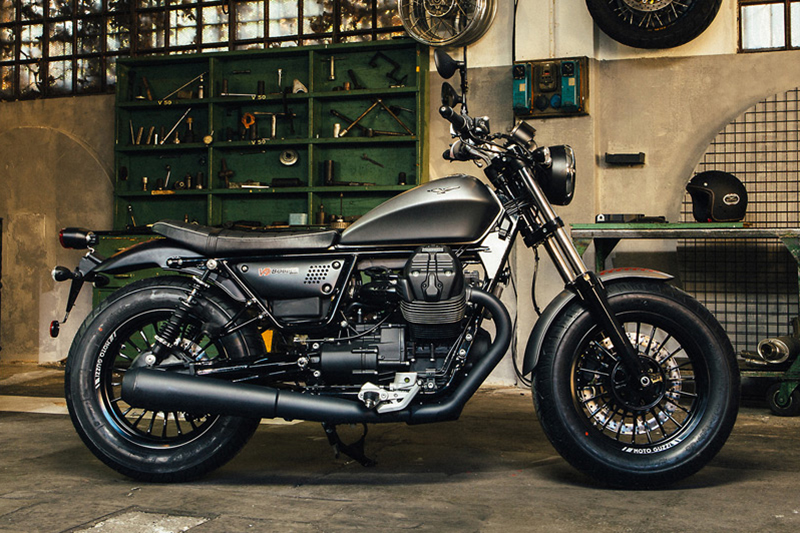2017 Moto Guzzi V9 Roamer and V9 Bobber

First Ride Review
Behind the big red gate at its Mandello del Lario factory, which bears the iconic soaring eagle logo, Moto Guzzi is in the midst of a major revival. During its 95th anniversary, the legendary Italian company introduced two neo-retro cruisers at its historic home on the picturesque shores of Lake Como, Italy. Powered by a new 853cc version of Moto Guzzi’s venerable “flying V” longitudinal V-twin, the classically-styled V9 Roamer and aggressive-looking V9 Bobber fill the void between the 744cc (V7 II models) and 1,151cc (Griso, Norge and Stelvio) engine families. Although they share the same platform and are aimed at the next generation of young, hip riders, the Roamer and Bobber differ in their style and riding personality.
With ’70s-era styling, the Roamer exudes old-school cool with a pullback handlebar and chrome vintage-style mirrors, exhaust pipes and dual shock springs. Its thick, wide bench seat is just 30.9 inches high and, with midmount footpegs, offers a neutral riding position that’s comfortable enough for long rides. The Roamer rolls on cast aluminum wheels painted matte black with a diamond-cut finish, with a 19-inch front shod with a narrow 100/90 tire and a 16-inch rear carrying a chunky 150/80. The large front wheel rolls smoothly over imperfections instead of plowing straight through them, which, along with the Roamer’s longer trail (4.9 inches vs. 4.6 on the Bobber), help it feel more comfortable and stable on the road.
Compared to the Roamer, with its gleaming chrome and gloss paint, the Bobber is its dark nemesis. Nearly everything is blacked-out, from the drag-style handlebar to the mirrors, springs and exhaust pipes. True to its name, the Bobber has a chopped rear fender, and its narrow, thinly-padded seat and flat handlebar give it a more aggressive, forward-leaning riding position. It has black 16-inch wheels front and rear with oversized tires (130/90 and 150/80 respectively). Perhaps due to the larger contact patch of its fatter front tire, the Bobber held its line better than the Roamer in tight turns. Whereas the Roamer’s front end felt vague after initial turn-in, the Bobber felt planted and predictable. Both of these bikes are compact, with a 57.7-inch wheelbase and claimed dry weight of just 439 pounds (which includes all fluids but fuel, so they should weigh about 465 pounds with their 4-gallon teardrop tanks full), which makes them easy to toss back and forth through bends.
The bikes’ shared air- and oil-cooled 853cc OHV V-twin is carried in a steel twin-tube cradle frame and has 2 valves per cylinder, new aluminum crankcases, heads, cylinders and pistons, and the engine is Euro 4 compliant. A new oil sump, vent system and oil lubrication circuit help reduce heat and frictional losses for better performance and fuel economy. In addition to their light weight, what makes the Roamer and Bobber such user-friendly motorcycles is a torque curve as flat as the surface of Lake Como. They pull strongly from 2,500 rpm up to 6,500 rpm, and it’s lights out by 7,000 rpm. At the crank, Moto Guzzi says they make 55 horsepower at 6,250 rpm and 46 lb-ft of torque at 3,000 rpm. While cruising around the perimeter of the deep-blue lake, both bikes exhibited excellent response from the Magneti Marelli fuel injection system. But when we transitioned to technical mountain switchbacks, throttle response felt slightly abrupt. Shifting the 6-speed transmission was spot-on; the engine pulse and every gear change could be felt and heard during the entire ride.
Suspension on both models is basic, with a non-adjustable fork with 5.1 inches of travel and a pair of preload-adjustable rear shocks with 3.8 inches of travel. At modest speeds the suspension delivered a comfortable ride, but at higher velocities the shocks became easily overwhelmed with hard hits and bottomed a few times. A pair of Brembo brakes, with a 4-pot front caliper squeezing a 320mm disc and a 2-pot rear caliper squeezing a 260mm disc, provide predictable stopping power at a peg-scraping pace. Two-channel ABS by Continental worked perfectly in simulated panic situations on wet pavement. The front tire on the Bobber chirped momentarily before releasing and reapplying. Standard traction control has two modes, “1 – dry” and “2 – wet,” or it can be turned off, but at full throttle in wet conditions I was hard pressed to get TC to engage.
Retro meets modern on the instrumentation, with a classic analog speedometer that has an inset digital multi-function display with odometer, fuel consumption, ambient temperature, gear position, shift indicator and more. Both bikes are configured with a multimedia system that allows you to wirelessly connect the bike to your smartphone. From a large menu of options, five parameters can be viewed simultaneously, such as a rev counter, instantaneous power, instantaneous torque, acceleration and more. There’s also a USB port on the right steering head for charging your device. There is a wealth of information at your fingertips, or you can do what I did and just stick it in 4th gear and enjoy the IMAX view through the Italian countryside.
Even though they’re at moderate price points, fit and finish on the Roamer ($9,990) and Bobber ($10,490) are superb. Moto Guzzi didn’t cut corners with plastic bodywork; the tank, side covers, levers and fenders are all made of steel or aluminum. In addition, Moto Guzzi offers more than 40 accessories to fully customize these bikes, all of which have been R&D tested and covered under warranty.
In life, you can’t always have it all. The Roamer has more comfort for the long haul, while the Bobber has a distinct advantage in the mountain passes. Sign me up for the Bobber, which manhandles the corners with plenty of attitude.
